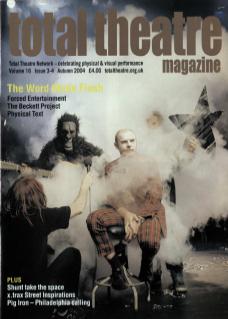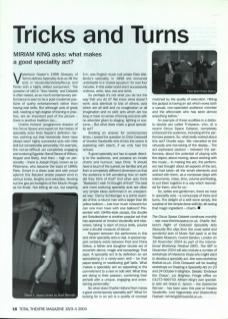Valantyne Napier's 1996 Glossary of Terms defines Speciality Acts as ‘All the acts in Vaudeville/Variety/Revue and Panto with a highly skilled component.' The question of skill in 'New Variety' and Cabaret is often raised, as so much contemporary performance is seen to be a post-modernist pastiche of quirky entertainment rather than having real skills. But although acts of great skill, needing a high degree of training or practice, are an important part of the picture – there is another tradition too...
Charlie Holland (programme director of the Circus Space and expert on the history of speciality acts) finds Napier's definition narrow, pointing out that historically there have always been highly successful acts with little skill but considerable personality. For example, the not-so-difficult yet completely engaging and enduring Egyptian Sand Dance of Wilson, Keppel and Betty. And then – high on personality – there is Joseph Pujol, known as Le Pétomane, who became the toast of 1890s Paris. Smart in a dress coat and with proud aplomb this flatulent artiste passed wind in various tones, lengths and velocities, blowing out the gas-jet footlights of the Moulin Rouge as his finale. Not letting air out, but keeping it in, was English music hall artiste Elsie Wallenda's speciality. In 1898 she remained underwater in a 'crystal aquarium' for over four minutes. In this water world she'd successively undress, write, sew, eat and drink.
So perhaps it's not what you do but the way that you do it? We know what doesn't work: acts identical to lots of others; acts which are all skill and no imagination or all imagination and no skill; acts which are too long or have no sense of timing and acts with no attention given to staging, lighting or costume... But what does make a good speciality act?
Seeking an answer for contemporary times, I posed the question to Chris Cresswell of Voodoo Vaudeville who thinks the scene is exploding with talent, if we only had the venues:
‘A good speciality act has to speak directly to the audience, and possess an innate charm and humour,' says Chris. 'It should have a touch of the surreal, be familiar and yet from a completely different dimension so that the audience is left wondering “how on earth did they think of that?” And other acts think "Bastards! I wish I'd thought of that!" The best and most enduring speciality acts are often very simple ideas performed in an unexpected way.' Danny Schlesinger is a prime example of this: a rotund man with a larger than life yellow balloon... Just how much innocent fun can one man have with one balloon? Presented with 1940s style pizazz, the double act Swizzleshaker is another popular act that has appeared at Voodoo Vaudeville and elsewhere, taking ‘a dash of circus skills, poured over a double measure of dance'.
Rapport between the performers in this and other speciality acts is vital. A special rapport certainly exists between Fred and China Delius, a father and daughter double act of eccentric dance, magic and escapology. Fred says: ‘A speciality act is by definition an act specialising in a rarely-seen skill – be that paper-tearing or swallowing golf balls. What makes a speciality act so appealing is the commitment to a rare or odd skill. What they are doing is their passion, combining their art/skill with a unique, engaging and entertaining personality.’
So what does Charlie Holland feel makes a good contemporary speciality act? ‘What I'm looking for in an act is a quality of concept matched by the quality of execution. Hitting the jackpot is having an act which wows both a casual, non-specialist audience member and the aficionado who has seen almost everything before.'
An example of these qualities is a diabolo double act called Tr'espace, who, at a recent Circus Space Cabaret, completely entranced the audience, including all the performers present. So, what really worked about this act? Charlie says: 'We marvelled at the virtuosity and risk-taking of the display... The act expressed passion - between the performers, about the potential of playing with the object, about moving, about working with the music... In making the act, the performers had thought about all aspects of the act, and had taken all the small elements and worked with them, as a composer plays with instruments, notes, time, volume and feeling, to put them together in a way which resonated for them, and for us.’
So, ladies and gentlemen, there we have it: speciality acts – a cornucopia of tricks and turns. The delight of a skill done simply, the surprise of the simple done skilfully, all oozing that magic ingredient – charm.
The Circus Space Cabaret continues monthly – see www.thecircuspace.co.uk Charlie Holland's Night of Celluloid Speciality Acts (favourite film clips from the most weird and wonderful acts of Music Hall past) is at the Theatre Museum, Covent Garden, London on 16 November 2004 as part of the International Workshop Festival (IWF). The IWF in November 2004 will also include a number of workshops of interest to those who might want to develop a speciality act. See www.workshopfestival.co.uk Chris Cresswell will be leading workshops on Creating a Speciality Act on 23 and 24 October in Brighton. Details: 'Embrace the Chaos', c/o Brighton Fringe office on 01273 699733. Miriam King's own speciality solo act Grace E. Spoon – the Scarecrow Woman – has been seen this year at Voodoo Vaudeville, Lost Vagueness and Glastonbury Festival: mimking@tinyworld.co.uk

